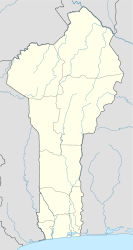Ajase
|
Porto-Novo Hogbonu, Àjàshé Ilé |
|
|---|---|
| City and commune | |

View on the lagoon of Porto-Novo
|
|
| Location of Porto-Novo in Benin | |
| Coordinates: 6°29′50″N 2°36′18″E / 6.49722°N 2.60500°ECoordinates: 6°29′50″N 2°36′18″E / 6.49722°N 2.60500°E | |
| Country |
|
| Department | Ouémé |
| Established | 16th century |
| Government | |
| • Mayor | Emmanuel Zossou |
| Area | |
| • City and commune | 110 km2 (40 sq mi) |
| • Metro | 110 km2 (40 sq mi) |
| Elevation | 38 m (125 ft) |
| Population (2009) | |
| • City and commune | 267,191 |
| • Density | 2,400/km2 (6,300/sq mi) |
| Website | Official website |
Porto-Novo (French pronunciation: [pɔʁtɔ.nɔvo]; also known as Hogbonu and Ajashe) is the capital of Benin, and was the capital of French Dahomey. The commune covers an area of 110 square kilometres (42 sq mi) and as of 2002 had a population of 223,552 people.
It was originally developed as a port for the slave trade, an important part of many European Empires at the time including the Portuguese Empire.
Porto-Novo is a port on an inlet of the Gulf of Guinea, in the southeastern portion of the country. It is Benin's second-largest city, and although Porto-Novo is the official capital, where the national legislature sits, the larger city of Cotonou is the seat of government, where most of the government buildings are situated and government departments operate. The region around Porto-Novo produces palm oil, cotton and kapok. Petroleum was discovered off the coast of the city in the 1990s, and has since then become an important export.
The capital's name Porto-Novo is of Portuguese origin, meaning "New Port".
Porto Novo comprises two ethnic communities, the Yoruba and the Gun. Although historically the aboriginals of the area were Yoruba speaking, there seem to have been a wave of migration from the region of Allada further west, which brought Te-Agbanlin and his group to the region of Ajashe. This newcomer group brought with them their own language, and settled among the original inhabitants, their Yoruba hosts. It would appear that each ethnic group has since maintained their ethnic nationalities without one group being linguistically assimilated into the other. Towards the end of the 19th century, the city came under French imperialistic ambitions and sphere of influence. Consequently, a community that had previously exhibited endoglossic bilingualism now began to exhibit exoglossic bilingualism, with the addition of French to the language repertoire of the city's inhabitants. Unlike the city's earlier Gun migrants however the French sought to impose their language in all spheres of life and completely stamp out the use and proliferation of indigenous languages.
...
Wikipedia

